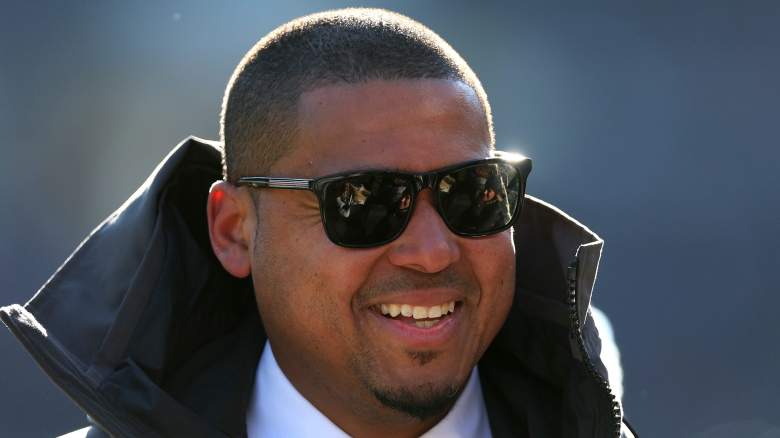Getty
General manager Ryan Poles of the Chicago Bears.
Prospective trades for the Chicago Bears’ top pick in the 2024 NFL draft will continue to roll in until the team either deals the selection or uses it to nab the QB of the future.
But until one or the other happens, how is it possible to gauge which teams are viable trade partners for Chicago or how much those franchises will actually sacrifice for the first pick? ESPN’s Bill Barnwell attempted to whittle down the answers to both questions on Thursday, February 1.
Barnwell examined recent trades in which a team dealt the No. 1 selection (or something close to it), contrasting the returns of each deal with the others. Excluding just one of seven agreements Barnwell included in his analysis – the Bears’ trade with 49ers swapping two third-rounders to move up from No. 3 to No. 2 in 2017 – clear patterns emerge regarding expected value.
To start, every deal included a first-round pick. Five of the six agreements included at least two first-rounders, and three firsts exchanged hands on two occasions. The average number of first-round picks swapped per trade was 2.17.
There is more to discuss on the topic, and circumstances will dictate Chicago’s precise return. However, the Bears dealt the top pick in 2023 for two firsts, two seconds, and wide receiver DJ Moore. As such, there is no reason to think that they would accept less than that for what is arguably a more valuable selection in 2024 considering the perception of this QB class.
Recent facts and Barnwell’s analysis then compute to the following:
Chicago’s expected return for the No. 1 pick in 2024 should be at least two first-rounders (one in 2024 and one in a following year), significant Day-2 capital (2-3 picks in the second- and/or third-rounds), and a star player.
Getty
USC quarterback Caleb Williams.
Generally, although not in every case, greater first-round compensation (and great compensation overall) was connected to trades in which teams moved from a pick in the double-digits up to one inside of the top-three.
The point being that the prospective trade partner will move the needle on what the Bears should expect to get back for trading the No. 1 overall selection. Another consideration is how said trade partner views the player, or pool of players, it can draft with that selection.
The sustained prowess of USC’s Caleb Williams and North Carolina’s Drake Maye should help the Bears’ expected return in this regard, while the ascension of LSU’s Jayden Daniels to Heisman Trophy winner and potential No. 2 or No. 3 pick also plays in Chicago’s favor.
Chicago Bears Quarterback Justin Fields could potentially be traded, according to an analysis by Bill Barnwell. Barnwell suggests that the Washington Commanders and New England Patriots, who have the second and third picks in the draft respectively, could be potential trade partners for the Bears. However, Barnwell believes that the Bears would receive the least value from these teams since they are in a position to draft a top quarterback regardless of their pick.
If the Bears decide to keep Fields, they could trade back a spot or two and gain significant value. They could then potentially trade again for additional assets such as two first-round picks, a star player, and more. On the other hand, if the Bears intend to trade Fields but still like a player available at the second or third pick, they could receive both draft assets and their future quarterback by trading the top pick.
Barnwell also mentions other potential trade partners that could offer the Bears a single-deal return. These teams include the Arizona Cardinals, New York Giants, Tennessee Titans, Atlanta Falcons, Denver Broncos, and Las Vegas Raiders. The Falcons and Raiders are particularly interesting cases because they would have to move up several spots to acquire the first overall pick. Both teams have new head coaches, and the Raiders recently hired Kliff Kingsbury, who was Fields’ quarterbacks coach at USC in 2023, as their offensive coordinator.
The Falcons have young talent that might intrigue the Bears, potentially saving the Falcons a Day-2 pick in the trade. Barnwell suggests that the Falcons could offer the Bears the eighth and 43rd picks in this year’s draft, along with first-round picks in 2025 and 2026, and a third-round pick in 2025 in exchange for the first overall pick.
In the case of the Raiders, Barnwell predicts that they would need to give up three first-round picks and more in order to acquire the top pick. He believes that the Bears are unlikely to trade down lower than the 13th pick, as they would be adding draft picks without any certainty about the available players. Barnwell’s prediction for the Bears’ return from the Raiders includes the 13th, 44th, and 77th picks in the 2024 draft, first-round picks in 2025 and 2026, a third-round pick in the following year, and a second-round pick in 2026.
In conclusion, Barnwell’s analysis suggests that the Bears have several potential trade partners for the first overall pick, each offering different trade scenarios and returns for the Bears. It remains to be seen whether the Bears will indeed trade Fields and what they will receive in return.












